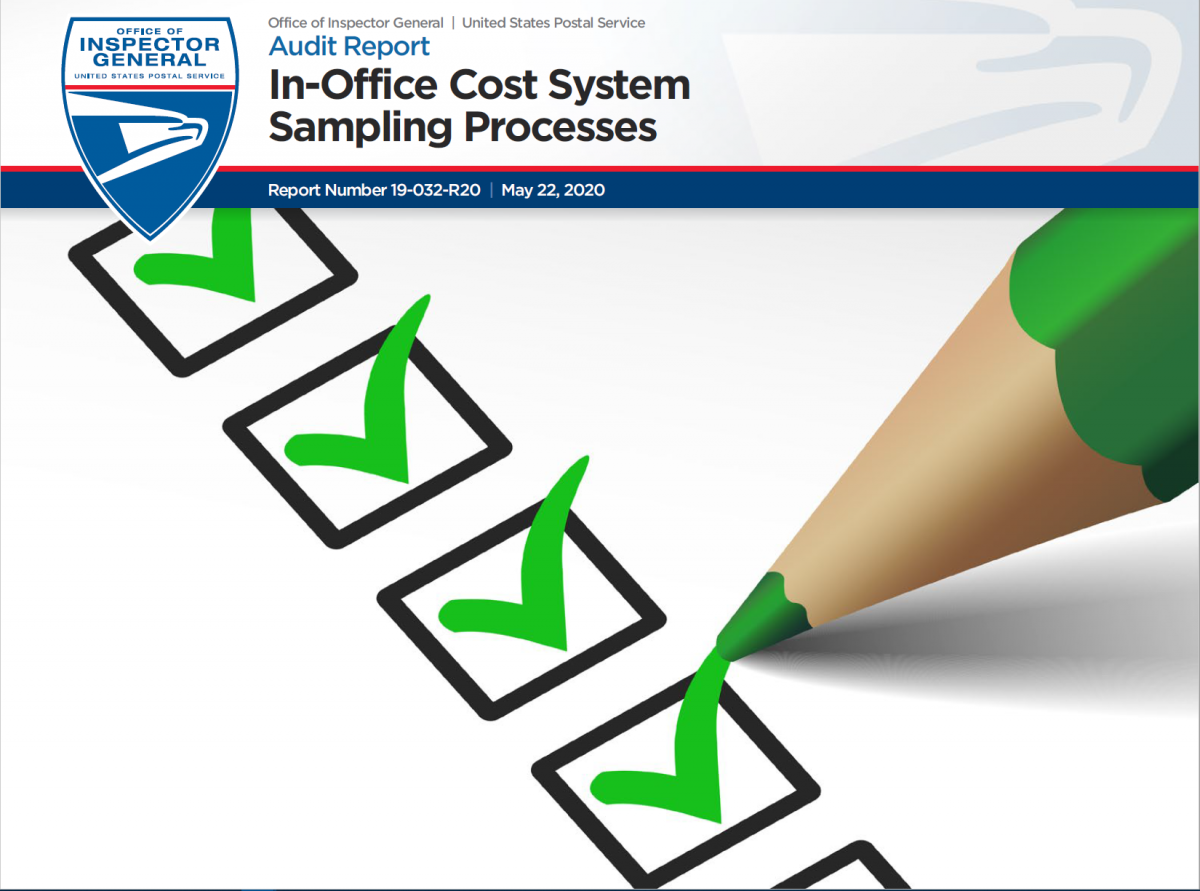Objective
The In-Office Cost System (IOCS) is the primary probability sampling system the U.S. Postal Service uses to attribute the labor costs of clerks, mail handlers, city carriers, and supervisors related to handling the mail. Data collected from IOCS enables the Postal Service to allocate labor costs to each mail category. The accuracy of product cost allocation is vital because the Postal Service is mandated to ensure all products cover their costs.
The IOCS is designed to supplement accounting system labor cost data by sampling mail handled by employees. Specifically, an IOCS reading is an observation that represents a snapshot of an employee’s work activities at selected points in time throughout the year. In fiscal year (FY) 2019, IOCS sampled readings cost the Postal Service over $14 million and included 214,789 in-person readings, 339,318 telephone readings, and 20,869 missing or cancelled readings.
In FY 2015, the Postal Service began developing a new methodology for conducting IOCS sampling to more accurately attribute city carriers’ labor costs. The primary objective of this new methodology, IOCS Cluster sampling, is to increase the number of in-person readings to capture mail characteristics data when carriers are on the premises and handling mail. The Postal Service must obtain regulator approval before applying this new methodology to current sampling processes.
While use of sampling data has been approved by the regulator, the Postal Service should continue seeking opportunities to use real-time census data for costing.
Our objective was to evaluate IOCS sampling processes to identify opportunities for improved efficiencies.
Our fieldwork was completed before the President of the U.S. issued the national emergency declaration concerning the novel coronavirus disease outbreak (COVID-19) on March 13, 2020. The results of this audit do not reflect any process and/or operational changes that may have occurred as a result of the pandemic. Given the circumstances of COVID-19, we are aware the Postal Service’s immediate priorities are the safety and security of its employees and the mail. We understand data collectors are not operating at full capacity at this time and current sampling efforts may be impacted, as well as finalizing and filing for any IOCS sampling methodological changes.
Findings
Opportunities exist for the Postal Service to improve IOCS sampling efficiencies. Specifically, the current sampling design results in a significant number of readings scheduled when employees are unavailable. In FY 2019, of the 554,107 total IOCS readings marked as completed, 257,154 (or about 46 percent) were conducted while the selected employees were unavailable. These readings note the employee’s status and were recorded as completed, even though no mail characteristics were captured. Additionally, readings for 50,304 (about 20 percent) of the total 257,154 unavailable employees were scheduled to be conducted in-person.
Management stated the current IOCS sampling system was not designed to substitute unavailable employees with employees available to conduct mail activities. In addition, although policy requires data collectors to verify sampled employees’ leave status prior to visiting a location, there was no process in place to validate if prior verification occurred. Samples completed for employees in leave status in FY 2019 resulted in 257,154 readings that did not collect mail characteristic data and could not be used to attribute costs to products. In addition, readings conducted in person for employees in leave status may have resulted in additional costs to the Postal Service.
Opportunities also exist for the Postal Service to improve the IOCS sampling plan to reduce cancelled readings. From FYs 2015 through 2019, cancelled readings increased by about 62 percent. In FY 2019, there were 19,005 cancelled readings which did not attribute costs to products. The increase in cancelled readings was largely a result of rescheduled readings that were not completed. Another major contributing factor to cancelled readings were those automatically cancelled during data collectors’ quarterly training. Management stated cancelled readings represent a small percentage of overall readings and are factored into the current sampling design. However, the number of cancelled readings in FY 2019 was 29 percent of the total number of readings that captured mail characteristics. Cancelled readings reduce opportunities to capture mail characteristics data needed for cost attribution.
Results from the IOCS Cluster sampling pilot indicate the pilot has increased efficiencies compared to the current IOCS sampling process. We identified some additional opportunities to further enhance the IOCS cluster sampling methodology, such as:
- Pilot Efficiencies: During our site visits, we found data collectors had idle time between readings. Enhancing the IOCS Cluster sampling pilot methodology to allow the system to reduce idle time would improve efficiency.
- Expanding IOCS Cluster Sampling: The pilot focused solely on capturing city carrier data because carriers are not always on-site, which resulted in missed opportunities to collect mail handling data. If the pilot expanded to other labor crafts, the Postal Service may be able to increase data captured for mail handling activities.
Recommendation
We recommended management:
- Evaluate and enhance, as appropriate, the IOCS sampling design to replace or reschedule readings of unavailable employees.
- Reiterate the verification policy and enhance the IOCS data entry system to indicate the verification of sampled employees work status in advance.
- Investigate cause(s) for increases in rescheduled readings that were cancelled and implement solutions to reduce cancelled readings, as appropriate.
- Document the methodology and analysis used to ensure sufficient samples are capturing mail characteristics for cost attribution.
- Enhance the cluster sampling methodology to reduce inefficiencies in the amount of time required to conduct readings.
- Analyze the expansion of the IOCS cluster sampling methodology to include other crafts, and implement a pilot as appropriate.
Read full report
Source: USPS Office of Inspector General

